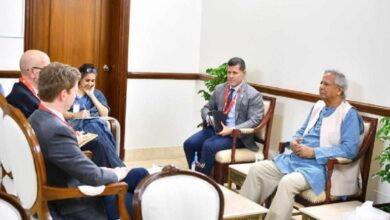Bangladesh eyes $1 billion semiconductor exports by 2030
Bangladesh’s semiconductor dreams started in the 2000s, but the key actuators emerged visible through their design services to major global giants in 2017.
The Bangladesh Semiconductor Industry Association (BSIA) has unveiled their roadmap to boost the country’s semiconductor exports to $1 billion by 2030, focusing on workforce training and policy support to drive growth.
The plan can be deemed ambitious as Bangladesh’s annual semiconductor design services exports remain below $10 million.
But, BSIA President MA Jabbar expressed confidence in reaching the target.
To achieve this, the BSIA plans to unlock the country’s semiconductor potential by training 10,000 engineers for semiconductor designing.
He said, “It [the target] is possible if we focus on workforce development, government policy advocacy, and advancing local research and development (R&D) capabilities.” He made the statement at a key meeting of non-resident Bangladeshi (NRB) semiconductor experts and local industry leaders.
The programme titled “Unlocking Bangladesh’s Potential: A Roadmap for Semiconductor Industry Development” took place at the Silicon Valley, California, USA earlier this week where around 70 NRB experts discussed how Bangladesh can have a fair share in the over $670 billion global market set to cross a trillion dollar benchmark by the end of this decade.
Bangladesh’s semiconductor dreams started in the 2000s, but the key actuators emerged visible through their design services to major global giants in 2017.
In 2022, some 400 chip designers deployed by three firms Ulkasemi, Neural Semiconductor, and Prime Silicon fetched $6 million in export earnings.
Neural Semiconductor CEO Md Shakhawat Hossain told The Business Standard that despite some challenges in 2023, annual exports surged to around $8 million with the industry engaging nearly 700 chip designers in 2024.
Though MA Jabbar’s semiconductor firm Ulkasemi and Neural Semiconductor are behind the most of the exports, the association of 13 firms is hopeful about the emergence of more names.
Talking to TBS, Shakhawat said despite the delayed start Bangladesh can thrive in the coming years.
Very large scale integration (VLSI), the subject teaching semiconductor, is being offered by around two dozen universities in Bangladesh and the industry has already collaborated with some of them, contributing to the progress made to date, he said.
VLSI technology was developed in the 1970s and has enabled the creation of complex semiconductor and telecommunications technologies. Simplified, it is the process of combining millions or billions of transistors onto a single chip to create an integrated circuit (IC).
“After learning about how other developing or emerging countries have evolved their chip industry, we were requesting the government for more support to the universities alongside special incentives for the industry,” Shakhawat said, adding that the responses till now were insufficient.
For instance, he said, countries like Malaysia and India during their beginning in the 1970s and 1980s offered 20%-25% cash incentives to the chip industry players against their exports, which were gradually brought down.
In Bangladesh, the chip design companies, only as members of the Bangladesh Association of Software and Information Services (BASIS), avail some 10% cash incentive on exports of “IT enabled services.”
To compete with the peer countries’, most having decades-old industries, and also thrive, the sector needs special care and an enabling ecosystem, he added.
“More importantly, we need 10,000 design engineers in the next five years and without a tremendous triangular effort by the industry, academia and the government it will be a tough job.”
The government should support human resources development, he said.
Shakhawat further said a popular design platform Cadence Design Systems waives their prices a lot for educational institutes, which is not the case for industry. Tk30 lakh charged for universities surges to crores for businesses.
Cadence makes software and hardware for designing products such as integrated circuits, systems on chips (SoCs), and printed circuit boards.
At the Silicon Valley event, NRB semiconductor expert Dr Yusuf Haque, co-founder and chief technology officer of eXo Imaging Inc, highlighted the latest advancements in semiconductor technology.
Alongside sharing his experience as the former managing director of Maxim Integrated Products, which he helped grow to over $2 billion in annual revenue, Yusuf highlighted how advancements in semiconductors, artificial intelligence and related technologies would disrupt developed economies and create significant opportunities for emerging economies like Bangladesh.
Moderated by Dr Khalid Azim, the panel included industry leaders such as Dr Yusuf, Mahbub Rashed, Rafi Hasan, and Rabbi Islam.
Speakers at the event said with the developed and emerging world governments pouring billions of dollars to secure a strong position in the fast growing global market of microchips, which are seeing an ever increasing use in a widening range of devices, the government vision and support is becoming more crucial.
Bangladesh has brains, but it needs to train them for the chip design sector first, after which it should eye chip testing, assembling plants while chip manufacturing should be targeted at the final stage, the speakers said, adding that alongside preparing a local ecosystem, global partnership will be crucial for the industry.
The semiconductor association plans to achieve significant milestones in the next decade, including local chip development, packaging, testing, and manufacturing.




